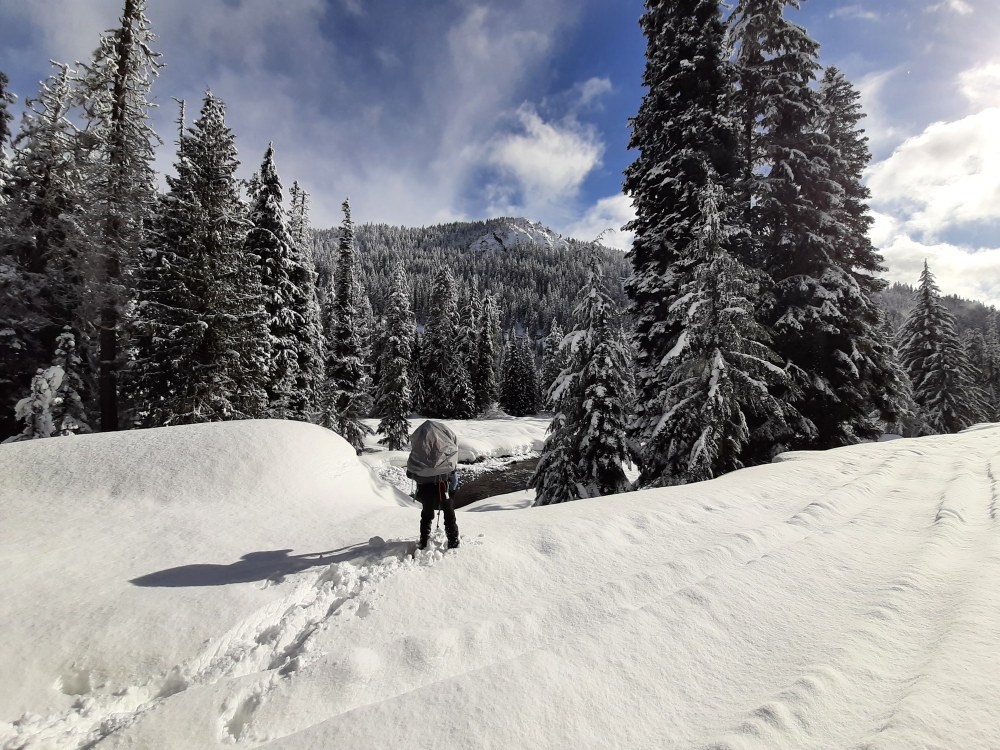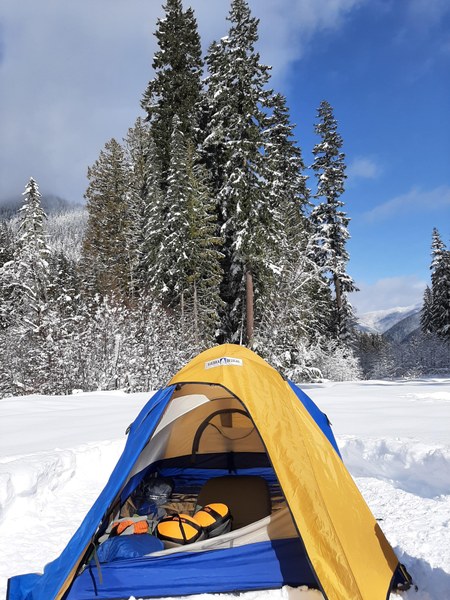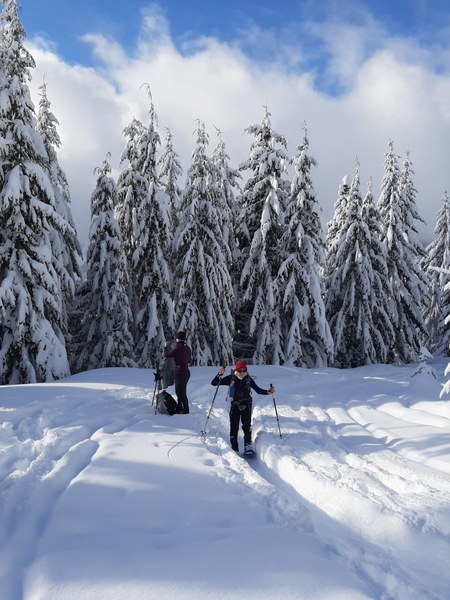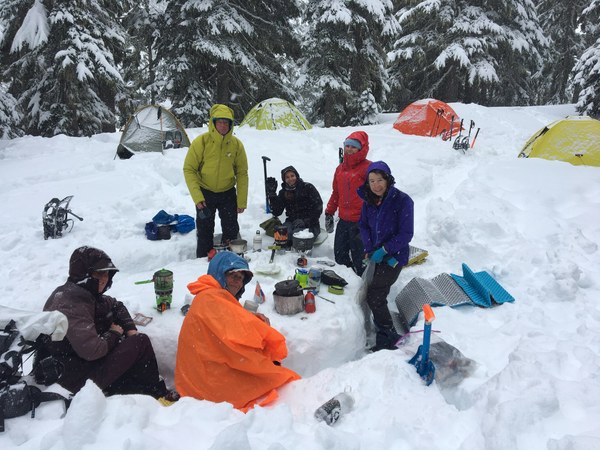
Many years ago, I spent my first snow camping trip on the Skyline Lake Trail opposite Stevens Pass Ski Resort. As we settled in for the night, I could see the slopes across the valley light up for night skiing and hear alpine music playing. Our side of the mountains was quiet and dark. I was a downhill skier at the time, and was charmed by the difference.
After a long hiatus, I decided to rediscover the magic of winter camping in 2021. I took a Winter Camping Course with the Tacoma Branch and found it just as delightful as I remembered. For those considering bundling up for the night in the snow, here are some key tips and tricks to make your stay in winter wonderland as comfortable and enjoyable as possible.
 A four-season tent filled with winter gear. Photo by Mike Kretzler.
A four-season tent filled with winter gear. Photo by Mike Kretzler.
Navigating in snow
Navigation is trickier in winter because many of the usual landmarks, such as signs, trails, and even terrain features, are obscured by snow. I prepare for this by building a route and downloading it to my GPS (and phone as a backup); this includes marking landmarks, baselines, and handrails, and may include compass bearings from one landmark to the next. I include all of that on a printed map as well. While it may seem that following a road would be straightforward – and it usually is – in bad weather it can be surprisingly difficult to find and stay on the road. And where there isn’t a road to follow, you’ll need those markers. But snow cover makes traveling much easier, too. You just stride over all the brush and downed trees on your snowshoes.
Managing avalanche danger
The real concern with winter camping is avalanche danger. My approach is to carefully review the slope angles for any avalanche terrain along the route, paying close attention to where I plan to camp, and avoiding terrain that presents any significant risk of avalanche. The slope angle and satellite layers in GaiaGPS and CalTopo are very useful for this. I also watch the avalanche forecast from the Northwest Avalanche Center, and take an avalanche awareness course every year to stay refreshed. Even experienced mountaineers can catch themselves in an avalanche; it pays to be cautious.
 Snowshoers on a trip to the first of the Kendall Peaks Lakes. Photo by Mike Kretzler.
Snowshoers on a trip to the first of the Kendall Peaks Lakes. Photo by Mike Kretzler.
Gear
Regular backpacking and snowshoe gear covers most of what you will need to get by in winter. Comfort and safety should be your goals, rather than a low base weight. Be prepared to bring more clothing than you think you'll need. Your tent should be at least a solid three-season model, though a four[1]season tent is preferred. It should have solid walls (not mesh) and be strongly made. Keep in mind that many lightweight single-person tents are quite narrow, which, when pressed by 18” of new snow, might seem narrower still. You’ll likely need a warmer sleeping bag and a more insulated sleeping pad than you use in other seasons (many people prefer to bring two pads for sleeping). I also bring two sit pads, one to sit on and one for under my boots. It’s surprising how effective a little insulation under your feet can be.
While I recommend carrying a tent on all trips, you can also build a shelter from the snow. I’ve seen an igloo built and found it to be an exceptional shelter - it was light and quiet inside, while the storm outside was dark and noisy. However, it took a group of experienced people all afternoon to build with nice, wind-packed snow. Another option is a snow cave, again, with the right terrain and enough snow. I’ve built a couple and spent three nights in them, and they are fine shelter. They require shovels, a few hours of teamwork, and the knowhow to make sure the structure is safe.
 Angela French building a kitchen for three below Box Canyon Road. Photo by Mike Kretzler.
Angela French building a kitchen for three below Box Canyon Road. Photo by Mike Kretzler.
Choosing a site
Finding camp sites in winter is harder in some ways and easier in others. Trees create lumpy, icy snow in our mountains, so find an open area in which to set up for the night. You never have to look hard for a flat place to set up your tent because you can flatten the area yourself, even on a slope, using your shovel and feet. Winter camping is also never crowded; even busy areas clear out by mid-afternoon. However, many places are inaccessible due to the snow and avalanche concerns. Be sure to have a strong working knowledge of avalanche danger before venturing out.
Camp cooking
Water is everywhere thanks to the snow, but you will need to melt it. Sometimes a creek is available, but depending on the snow it can be risky to gather. You’re better off planning
to melt snow, which will generally require using two to three times the amount of fuel you’d use on a summer trip for your winter trip. White gas stoves perform better in winter temperatures than canister fuel stoves. You’ll need a bigger pot than usual, as snow is voluminous until it melts. I bring two cups in winter, which leaves one available for scooping snow into the pot as needed. I also bring an insulated pouch for my dinner and a koozie for my cup, both made from foam duct insulation.
If you’re in a group, you can build a shared kitchen. Stamp out a large circular (or rectangular) area, digging out a foot well and seating area around a table in the middle. It’s a fun way to create a social focus for the trip and stay warm in the process. Just be sure to fill in all of the constructions when you break camp. When winter camping solo, I carve out a foot well in my tent’s vestibule so that I can sit in the tent and have my stove just outside the tent on its platform, all at a comfortable height.
LNT and wildlife concerns
Leave No Trace practices are also different in winter. Our camping platforms melt away in the spring, but our poop does not. Be prepared to carry yours out. A blue bag, WAG bag, or even a kit built of some waxed paper and a dog poop bag can make this easy. A plastic mayo jar is a good way to securely transport your waste. While bears are supposed to be sleeping if there’s snow on the ground, it still pays to protect your food. Foxes are a particular issue on Mt. Rainier, I understand. Bring a way to hang your food out of reach or use a bear canister.
 Meal prep at the kitchen site on an overnight trip to Kendall Peaks Lakes. Photo by Tricia Belcastro.
Meal prep at the kitchen site on an overnight trip to Kendall Peaks Lakes. Photo by Tricia Belcastro.
Winter camping courses
I had the opportunity to take Tacoma’s Winter Camping course in 2021; it was excellent and offered a lot of helpful information and gear advice, which helped me feel confident on my first night out. Below are some upcoming Winter Camping Courses to check out this season:
- Seattle: Snowshoe/Winter Camping Course, Feb 9-Apr 9, 2023
- Foothills: Winter Camping Course, Feb 15-Apr 10, 2023 Winter Camping Course, Feb 15-Apr 10, 2023
This article originally appeared in our winter 2023 issue of Mountaineer Magazine. To view the original article in magazine form and read more stories from our publication, visit our magazine archive.
 Mike Kretzler
Mike Kretzler